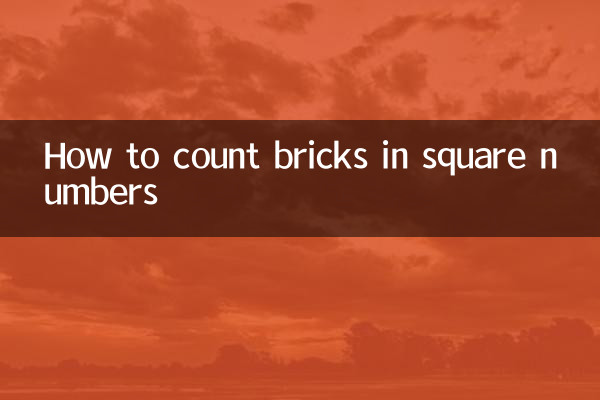How to count bricks in square numbers
In recent years, with the rapid development of the construction industry, how to efficiently calculate the usage of building materials has become a hot topic. This article will combine the hot content on the Internet in the past 10 days to introduce you in detail how to calculate the amount of bricks based on square numbers, and provide structured data for reference.
1. Why do we need to calculate the amount of bricks in square numbers?

Bricks are one of the most commonly used materials in building construction. Accurately calculating the amount of bricks not only saves costs but also avoids material waste. According to recent hot discussions, many construction practitioners and DIY enthusiasts are paying attention to how to quickly and accurately count the number of bricks.
2. Basic method for calculating the amount of bricks
The core formula for calculating the amount of bricks is:
Number of bricks = area (square meters) × number of bricks required per square meter
The following is a reference table of common brick sizes and corresponding amounts per square meter:
| Brick type | Dimensions (mm) | Amount per square meter (blocks) |
|---|---|---|
| Standard red brick | 240×115×53 | About 128 yuan |
| hollow brick | 390×190×190 | About 12.5 yuan |
| lightweight brick | 600×200×100 | About 8.3 yuan |
3. Actual case analysis
Assuming you need to build a 10 square meter wall, using standard red bricks, the calculation steps are as follows:
1. Determine the brick type: standard red brick (128 bricks per square meter).
2. Calculate the total consumption: 10 square meters × 128 pieces/square meter = 1280 pieces.
3. Consider loss: usually add 5%-10% loss, and finally need to prepare about 1,400 bricks.
4. Hot topic on the entire network: How to optimize brick calculation?
In the past 10 days, the following topics have been highly discussed in the construction field:
| hot topics | focus of discussion |
|---|---|
| AI-assisted calculation of brick usage | How to use smart tools to quickly generate a bill of materials |
| The choice of environmentally friendly bricks | The impact of new materials on dosage calculations |
| DIY building boom | How to accurately calculate the usage of small projects |
5. Things to note
1. Different masonry methods (such as straight masonry and side masonry) will affect the amount of bricks and need to be adjusted according to the actual design.
2. The brick joint thickness (usually 10mm) needs to be included in the calculation range.
3. It is recommended to reserve 5%-10% margin when purchasing to avoid delays in replenishment.
Conclusion
With the structured data and methods in this article, you can easily master the art of counting bricks on square numbers. Based on current hot topics, it is recommended to pay attention to the development trends of intelligent tools and environmentally friendly materials to further improve construction efficiency and quality.

check the details

check the details